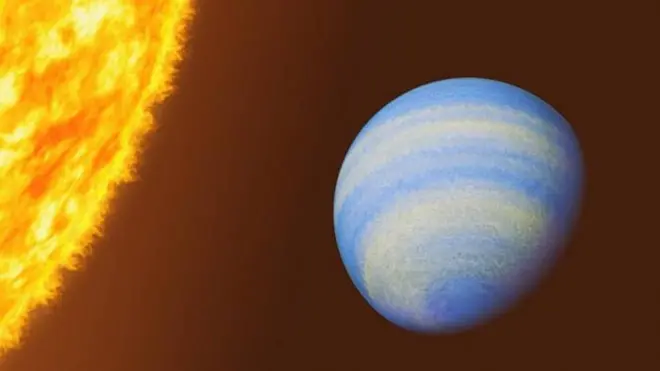For a long time, it was believed that Earth was unique among the planets in our Solar System in possessing an ocean. However, a new perspective has emerged, suggesting the presence of subsurface oceans even on the coldest and most unexpected celestial bodies.
In fact, icy moons and dwarf planets in the farthest reaches of the Solar System appear to harbor liquid oceans beneath thick layers of ice. Recent studies indicate that even celestial bodies beyond Pluto may host oceans. This is remarkable, considering these bodies have surface temperatures below -200°C.
Seventy years ago, it was hypothesized that Venus might possess a global ocean, protected by its warm atmosphere. However, in 1962, NASA’s Mariner 2 probe revealed, upon passing by Venus, that its surface was far too hot to sustain liquid water.

Since then, we have come to understand that any ocean that might have existed on Venus, as well as on Mars, disappeared billions of years ago due to massive climate transformations.
The turning point in how we view oceans in our Solar System can be traced back to a 1979 paper by astrophysicist Stan Peale. In it, Peale predicted that Jupiter’s innermost moon, Io, could be internally hot enough to be volcanically active.
The source of this heat lies in a gravitational phenomenon—the repeated tidal interactions between Io and its closest neighbor, Europa.
Europa completes exactly one orbit for every two orbits of Io. Thus, every two orbits, Io overtakes Europa, repeatedly pulled by Europa’s tidal forces, preventing its orbit from becoming circular.
This means the distance between Io and Jupiter is constantly changing—and so is the intensity of Jupiter’s (much stronger) tidal force, causing distortions in Io’s shape.
This repeated tidal distortion generates heat within Io through internal friction, much like bending a stiff wire back and forth multiple times. If you touch the bent area with your lips (try this with a coat hanger or a paperclip), you’ll feel the heat.
Confirmation of Peale’s tidal heating prediction came just a week after the paper’s publication, when Voyager 1 performed the first detailed flyby of Jupiter and sent back stunning images of erupting volcanoes on Io.
Although Io is a rocky world devoid of any water, this might seem unrelated to oceans. However, the tidal interactions between Jupiter, Io, and Europa operate in both directions. Europa, too, is heated by tides, not only from Io but also from the next moon, Ganymede.
Today, substantial evidence suggests the presence of an ocean about 100 km deep beneath Europa’s icy surface, nestled between its crust and rocky core. Ganymede, in turn, might harbor three or four liquid layers, sandwiched between layers of ice.
In these cases, the heat preventing the liquid water from freezing is likely generated primarily by tidal forces.
Additionally, there are indications of a region of salty liquid water within Callisto, Jupiter’s outermost moon. However, this phenomenon is less likely caused by tidal heating and more by heat from radioactive decay in its interior.
Saturn hosts a relatively small icy moon called Enceladus, with a radius of 504 km, which contains an internal ocean due to tidal heating from interactions with its larger moon, Dione. The existence of this ocean has been confirmed by the oscillation of Enceladus’ icy shell—an oscillation only possible if the shell is not firmly attached to the moon’s interior.
Moreover, the Cassini spacecraft collected samples of water and residual components from Enceladus’ internal ocean. Its measurements suggest that the ocean water has reacted with hot rocks below the ocean floor, indicating that its chemistry might be suitable to sustain microbial life.
Surprisingly, even moons not expected to be affected by tidal heating, as well as non-moon celestial bodies, continue to reveal evidence of internal oceans. The list of worlds that may harbor, or once harbored, internal oceans includes various moons of Uranus, such as Ariel and Triton, Neptune’s largest moon, and Pluto.
The closest internal ocean to the Sun may be within the dwarf planet Ceres, though it is largely frozen or potentially consists of a saline sludge.
Indeed, recent discoveries from the James Webb Space Telescope have been truly fascinating, particularly regarding ocean worlds far beyond Pluto. These findings stem from analyses of isotope ratios in the frozen methane covering Eris and Makemake, two dwarf planets slightly smaller and significantly farther than Pluto.
Scientists behind these studies claim that their observations provide evidence of chemical reactions between the internal ocean water of these celestial bodies and their rocky ocean beds. They also suggest the presence of water plumes, some potentially active today. They propose that heat from the radioactive decay of elements within the rocks is sufficient to explain how these internal oceans have been maintained at temperatures that prevent freezing.
These discoveries greatly expand our understanding of the potential for oceans beyond the known boundaries of our Solar System, pointing to the diversity and complexity of worlds that may host liquid water in their interiors.
It’s true these findings prompt the question: could alien life exist within these distant oceanic worlds?
However, several papers presented at this year’s Lunar and Planetary Science Conference in Houston suggest that the rock beneath Europa’s ocean floor may be too rigid to allow the formation of hydrothermal vents, such as those essential for the development of microbial life on early Earth.
These findings raise significant questions about the habitability of these subsurface oceans. It’s possible that other ocean worlds face similar challenges, making them potentially inhospitable to life as we know it.
Nonetheless, despite these concerns, hope remains. Continued exploration of these celestial bodies and deeper investigations of their internal environments may reveal new insights that could alter our understanding of extraterrestrial life. Thus, while challenges exist, the future of the search for life beyond Earth remains thrilling and full of possibilities.

